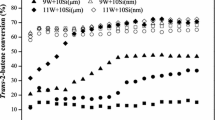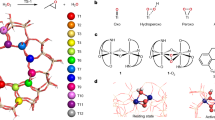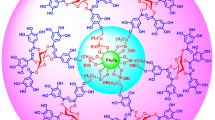Si02-supported tantalum clusters were prepared by adsorption of the precursor Ta(CH2Ph)5 (Ph is phenyl) on the support followed by treatments in H2 at 523, 623, and 723 K. The resultant clusters, had approximate average diameters of 0.3, 0.8, and 2 nm, as determined by extended X-ray absorption fine structure (EXAFS) spectroscopy. The samples were tested as catalysts for conversion of methane with n-butane in a once-through flow reactor operated at atmospheric pressure and 523 K, and EXAFS spectroscopy was used to characterize the used catalysts. The results show that (a) the catalysts are active for the conversion of methane with n-butane to give ethane, propane, and pentanes; (b) catalytic activity decreased to nearly zero over a time on stream of 22 h; (c) the catalyst incorporating the smallest clusters exhibited the highest initial activity and that incorporating the largest clusters exhibited the lowest activity; (d) each used catalyst contained clusters of approximately the same nuclearity as the respective fresh catalyst, but with Ta–Ta bond lengths approximately 0.17 Å longer than those found in the fresh catalysts. The data are consistent with catalysis by the supported clusters, and the product distributions are consistent with disproportionation of n-butane accompanied by the reaction of methane with propane to give other alkanes.







Similar content being viewed by others
References
Nemana S., Gates B.C., (2006) .Langmuir 22 :8214
Jentoft R.E., Deutsch S.E., Gates B.C. (1996) . Rev. Sci. Instrum 67:2111
Vaarkarnp M., Linders J.C., Koningsberger D.C. (1995) . Physica B 209:159
Koningsberger D.C., Mojet B.L., van Dorssen G.E., Ramaker D.E. (2000) . Top. Catal. 10:143
Zabinsky S.I., Rehr J.J., Ankudinov A., Albers R.C., Eller M.J. (1995) . Phys. Rev. B 52:2995
R.W.G. Wyckoff (ed.), in: Crystal Structures 2nd ed., Vol. 1, (Wiley, New York, 1963) p. 16.
P. Villars and L.D. Calvert (eds.), in: Pearson′s Handbook of Crystallographic Data for Intermetallic Phases 2nd ed., Vol. 4, (ASM International, Metals Park OH, 1991) p. 5253.
Aleshina L.A., Longinova S.V. (2002) . Crystallogr. Rep. 47:415
The data indicate an induction period of several hours during which little ethane was produced although substantial methane was converted; we lack mass balance data to explain the observation.
The IR spectra of the unused catalysts treated in H2 give no evidence of hydrocarbon ligands, indicated by the lack of C–C and C–H stretching bands in the IR spectrum. Thus, there is no evidence of carbon on the catalyst prior to catalytic testing.
If the clusters had grown perpendicular to the SiO2 surface, we would expect the Ta–O coordination number to have decreased, in contrast to the observations.
As a control experiment, a sample that had been pretreated at 523 K in H2 was exposed to air, and the EXAFS spectrum was acquired. The Ta–O coordination number was determined to be 5.4, an increase of two over the freshly treated sample. Details of this sample are given elsewhere [13].
Abbenhuis H.C.L., Rietveld M.P., Haarman H.F., Hogerheide M.P., Spek A.L., van Koten G. (1994) . Organometallics 13:3259
Rietveld M.H.P., Teunissen W., Hagen H., van de Water L., Grove D.M., van der Schaaf P.A., Muhlebach A., Kooijman H., Smeets W.J.J., Veldman N., Spek A.L., van Koten G. (1997) . Organometallics 16:1674
De Castro I., de la Mata J., Gomez M., Gomez-Sal P., Royo P., Selas J.M. (1992) . Polyhedron 11:1023
K.I. Pandya and D.C. Koningsberger, Physica B 158 (1989) 386. Backscattering amplitudes of C and 0 used in EXAFS data analysis are not transferable, and the reference compound used to fit Ta–O contributions is generally not used to fit Ta–C contributions [16]. In our EXAFS data analysis, inclusion of C in the fitting process using a separate Ta–C reference is not justified because of the inability of the technique to distinguish between C and O atoms when they occur at nearly the same distance from the absorber atom. Moreover, attempts at fitting Ta–C contributions at other distances failed. Our use of the Ta–O reference compound to analyze the contributions at 1.90 and 1.89 Å for the used catalysts that had been pretreated at 523 and 623 K, respectively (which we suggest contained Ta = C groups), gives rise to large uncertainties [16] in the increase observed for the Ta–O coordination number as a result of contact of the catalyst with reactants, because, we infer, the contribution is associated with both Ta–C and Ta–O.
Vidal V., Theolier A., Thivolle-Cazat J., Basset J.-M. (1997) . Science 276:99
S. Nemana and B.C. Gates, J. Chem. Soc, Chem. Commun (2006) 3996.
Soulivong D., Coperet C., Thivolle-Cazat T., Basset J.M., Maunders B.M., Pardy R.B.A., Sunley G.J. (2004) . Angew. Chem. Int. Ed. 43:5366
Cotton F.A., Diebold M.P., Feng X., Roth W.J. (1988) . Inorg. Chem. 27:3413
Nemana S., Gates B.C. (2006) . J. Phys. Chem. B 110:17546
Further evidence that the metal oxidation state increased upon contact of the sample with the reactants is evident from the change in the XANES edge position, which increased to higher energy by 0.5 eV relative to the freshly treated catalyst.
Acknowledgments
We thank the National Science Foundation for support (grant CTS-03000982). We acknowledge beam time and the support of the U.S. Department of Energy for its role in the operation of beam line X-18B at the National Synchrotron light Source. We also acknowledge the Stanford Syricluotron Radiation Laboratory, operated by Stanford University for the U.S. Department of Energy, Office of Basic Sciences, for access to beam line 2–3. The EXAFS data were analyzed with the software XDAP [3].
Author information
Authors and Affiliations
Corresponding author
Rights and permissions
About this article
Cite this article
Nemana, S., Gates, B.C. Silica-supported tantalum clusters: catalysts for conversion of methane with n-butane to give ethane, propane, and pentanes. Catal Lett 113, 73–81 (2007). https://doi.org/10.1007/s10562-007-9028-6
Received:
Accepted:
Published:
Issue Date:
DOI: https://doi.org/10.1007/s10562-007-9028-6




